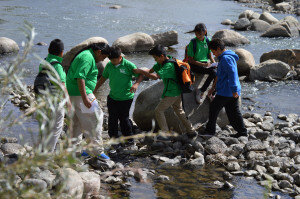Education: Learning Through the Truckee River
By Alex HoeftMcCarran Ranch Preserve is a peaceful place.Twenty or so minutes from downtown Reno, the Truckee River flows alongside the preserve’s rippling trees and a slightly worn path. It’s a breezy Wednesday in mid-September, and at different points along that slightly worn path are three groups of about 15 fifth graders from Dorothy Lemelson STEM Academy. Some have water-sogged shoes; others hold up clear plastic cylinders with dead crawfish floating inside. All of them, however, are learning.Sierra Nevada Journeys is a nonprofit organization bent on enlightening local youth of natural resource stewardship. Hands in the River is a specific program under Sierra Nevada Journeys devoted to the science of the Truckee River watershed, and it's what brings these fifth graders to the McCarran Ranch Preserve. The program is true to its title: the fifth grade participants get their hands (and feet) in the river.“Right now they’re looking for micro-invertebrates in the water,” said program coordinator and instructor Jamie Garaventa, with one eye on a group of kids gathered near the river bank, “and we talk about tolerant and intolerant species, and how scientists can use that as evidence of health of our water system.”Hands in the River allows fifth grade classes to learn about the Truckee River watershed over the course of two 90-minute in-classroom lessons, apply those lessons on a half-day field trip, and assess those learnings in a follow-up lesson back in the classroom. The two 90-minute lessons pre-field trip begin with the definition of a watershed and what the Truckee River watershed encompasses. From there the lessons navigate through storm drain and water cycle discussions; talks of preventing garbage, etc. from getting into the storm drains at schools and native versus invasive species. Usually at least one student in each class is able to identify drought as an interaction between the local watershed and water cycle.Water conservation as a topic isn’t discussed in the classroom or under formal instruction. Instead, it usually appears on a field trip when a fifth grader starts pouring out his or her bottle of water. (“Because that’s what kids seem to like to do with their bottles of water,” laughed Garaventa.) At that point, a casual discussion ensues.
The program is true to its title: the fifth grade participants get their hands (and feet) in the river.“Right now they’re looking for micro-invertebrates in the water,” said program coordinator and instructor Jamie Garaventa, with one eye on a group of kids gathered near the river bank, “and we talk about tolerant and intolerant species, and how scientists can use that as evidence of health of our water system.”Hands in the River allows fifth grade classes to learn about the Truckee River watershed over the course of two 90-minute in-classroom lessons, apply those lessons on a half-day field trip, and assess those learnings in a follow-up lesson back in the classroom. The two 90-minute lessons pre-field trip begin with the definition of a watershed and what the Truckee River watershed encompasses. From there the lessons navigate through storm drain and water cycle discussions; talks of preventing garbage, etc. from getting into the storm drains at schools and native versus invasive species. Usually at least one student in each class is able to identify drought as an interaction between the local watershed and water cycle.Water conservation as a topic isn’t discussed in the classroom or under formal instruction. Instead, it usually appears on a field trip when a fifth grader starts pouring out his or her bottle of water. (“Because that’s what kids seem to like to do with their bottles of water,” laughed Garaventa.) At that point, a casual discussion ensues. The effects of the drought in Northern Nevada have resulted in fodder for Hands in the River lessons. As an instructor, Garaventa explained the lines on the rocks are examples of drought, as well as new spots along the river that were once covered in water are “some great examples (for) talking about what’s currently happening in the watershed.”The program only runs during the school year, from September to November, and March through June. No field trips are attempted during the winter due to inclement weather and lack of scientific specimens.Hands in the River isn’t the only Truckee River-devoted program at Sierra Nevada Journeys.Jamie Garaventa on Hands in the River, Habits and Habitats (the third grade program at Oxbow Nature Study Area): [audio mp3="http://onetruckeeriver.org/wp-content/uploads/2015/10/SNJ-Jamie.mp3"][/audio]CEO Eaton Dunkelberger explained Sierra Nevada Journeys wants to harness real-world issues in whatever way possible. “I definitely think the drought provides an incredible learning opportunity for the kids,” Dunkelberger said. “One of the reasons it’s incredible . . . is because it’s very real and tangible for the kids.”There are two takeaways Dunkelberger sees emerging from Hands in the River and Habits and Habitats. One, he said, is a content-based piece: What are the things students individually can do to protect their watershed? The second involves critical thinking -- How can the students think through issues in the future that affect the world around them? What are the critical thinking skills they can pull away from this?For Garaventa, the takeaways she hopes to see are a little more personal.
The effects of the drought in Northern Nevada have resulted in fodder for Hands in the River lessons. As an instructor, Garaventa explained the lines on the rocks are examples of drought, as well as new spots along the river that were once covered in water are “some great examples (for) talking about what’s currently happening in the watershed.”The program only runs during the school year, from September to November, and March through June. No field trips are attempted during the winter due to inclement weather and lack of scientific specimens.Hands in the River isn’t the only Truckee River-devoted program at Sierra Nevada Journeys.Jamie Garaventa on Hands in the River, Habits and Habitats (the third grade program at Oxbow Nature Study Area): [audio mp3="http://onetruckeeriver.org/wp-content/uploads/2015/10/SNJ-Jamie.mp3"][/audio]CEO Eaton Dunkelberger explained Sierra Nevada Journeys wants to harness real-world issues in whatever way possible. “I definitely think the drought provides an incredible learning opportunity for the kids,” Dunkelberger said. “One of the reasons it’s incredible . . . is because it’s very real and tangible for the kids.”There are two takeaways Dunkelberger sees emerging from Hands in the River and Habits and Habitats. One, he said, is a content-based piece: What are the things students individually can do to protect their watershed? The second involves critical thinking -- How can the students think through issues in the future that affect the world around them? What are the critical thinking skills they can pull away from this?For Garaventa, the takeaways she hopes to see are a little more personal. Garaventa worked with Sierra Nevada Journeys for three years and lived in Reno 15 years prior to her coordinator position. She said that until she started working for Sierra Nevada Journeys, she didn’t know that Reno’s water came from the Truckee River.That lack of knowledge, she furthered, is something she doesn’t want true for the students she teaches.“I feel like they definitely walk away having a better understanding of where water comes from. At the start, almost no students know that our water comes from the Truckee River,” Garaventa said. “That’s definitely one of the main things I want people to walk away knowing, and that kind of leads into understanding how we use our water.”
Garaventa worked with Sierra Nevada Journeys for three years and lived in Reno 15 years prior to her coordinator position. She said that until she started working for Sierra Nevada Journeys, she didn’t know that Reno’s water came from the Truckee River.That lack of knowledge, she furthered, is something she doesn’t want true for the students she teaches.“I feel like they definitely walk away having a better understanding of where water comes from. At the start, almost no students know that our water comes from the Truckee River,” Garaventa said. “That’s definitely one of the main things I want people to walk away knowing, and that kind of leads into understanding how we use our water.”
